The United States Bicentennial happened in 1976, making it a memorable year. And to commemorate the momentous year, the U.S. Mint released Bicentennial coinage featuring special designs on the quarter, half-dollar, and dollar coins. However, the penny did not receive a special bicentennial design.
So, does this reduce its worth? Despite the plans not bearing fruition, it does not make the 1976 Lincoln Penny any less. Some varieties can fetch hundreds to thousands. And if you want to know which sells a premium and how much your 1976 Lincoln Penny is worth today, keep reading.
1976 Lincoln Penny Valuation Summary
Before we discuss each variety, here’s a value chart to give you a quick overview of how much a 1976 Lincoln Penny is.
| Regular Strike 1976 Penny Value Chart | |||||
| Mint Location | MS BN | MS RB | MS RD | ||
| Philadelphia | $0.05-$7.50 | $5-$15 | $7.50-$60 | ||
| Denver | $0.05-$7.50 | $5-$15 | $10-$825 | ||
| Proof 1976 Penny Value Chart | |||||
| Mint Location | PF RDC | PF RDU | |||
| San Francisco | $1.50-$35 | $0.25-$130 | |||
1976 Lincoln Penny Information
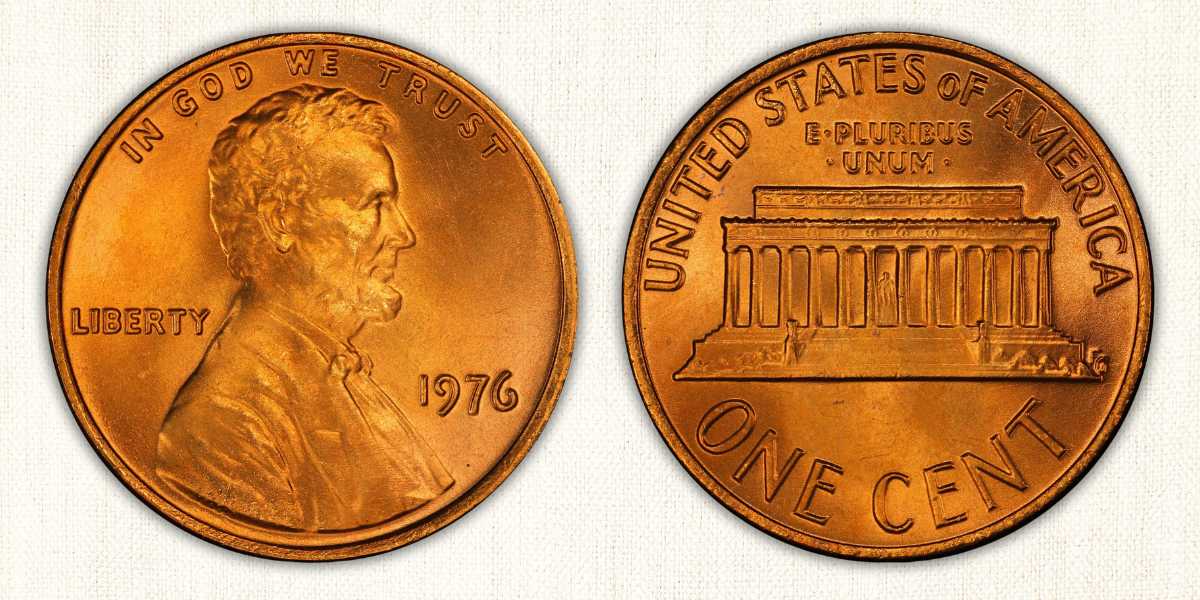
- Category: Lincoln Cents, Memorial Reverse (Type 3, 1959-1982)
- Face Value: One Cent
- Obverse Designer: Victor D. Brenner
- Reverse Designer: Frank Gasparro
- Metal Composition: Brass (95% Copper, 5% Zinc)
- Weight: 3.11 grams
- Diameter: 19 millimeter
- Edge: Plain
The obverse design of the 1976 Lincoln Cent is closely similar to the original version—although somehow larger in size. The date still appears on the right side of the coin, and the word LIBERTY on the left side.
Then, on the top is the arched text that reads, IN GOD WE TRUST. However, the reverse side completely changed, with the Lincoln Memorial as its main element instead of the famous wheat stalks since its redesign in 1959.
1976 Lincoln Penny Color Grading
The 1976 Lincoln Penny has a total mintage of 8,900,034,611. These were minted in Philadelphia, Denver, and San Francisco—creating three varieties. It has proof coins with cameo contrast and regular strike cents that are colored-keyed to Brown (BN), Red-Brown (RB), and Red.

But before we delve deeper into their market values, let’s first understand what color grading means for regular strike coins.
- Brown (BN) – These are circulated copper coins with less than 5% of their original color. But there are uncirculated coins that also have a BN designation.
- Red-Brown (RB) – These coins are less exposed to atmospheric elements (e.g., warm or moist settings). It retained 5% to 95% of its original red color.
- Red (RD) – These coins are well-preserved, helping it maintain 95% and above of its original red mint color.
In the numismatic marketplace, it is easy to say that those with Red grading offer better eye appeal than the two. But that is not to say that BN and RB are not worth anything. Coin color, still, is a matter of choice for varying collectors.
Now—let’s see how much each variety is worth today and which coin can fetch a fortune.
1976 No Mint Mark Lincoln Penny Value
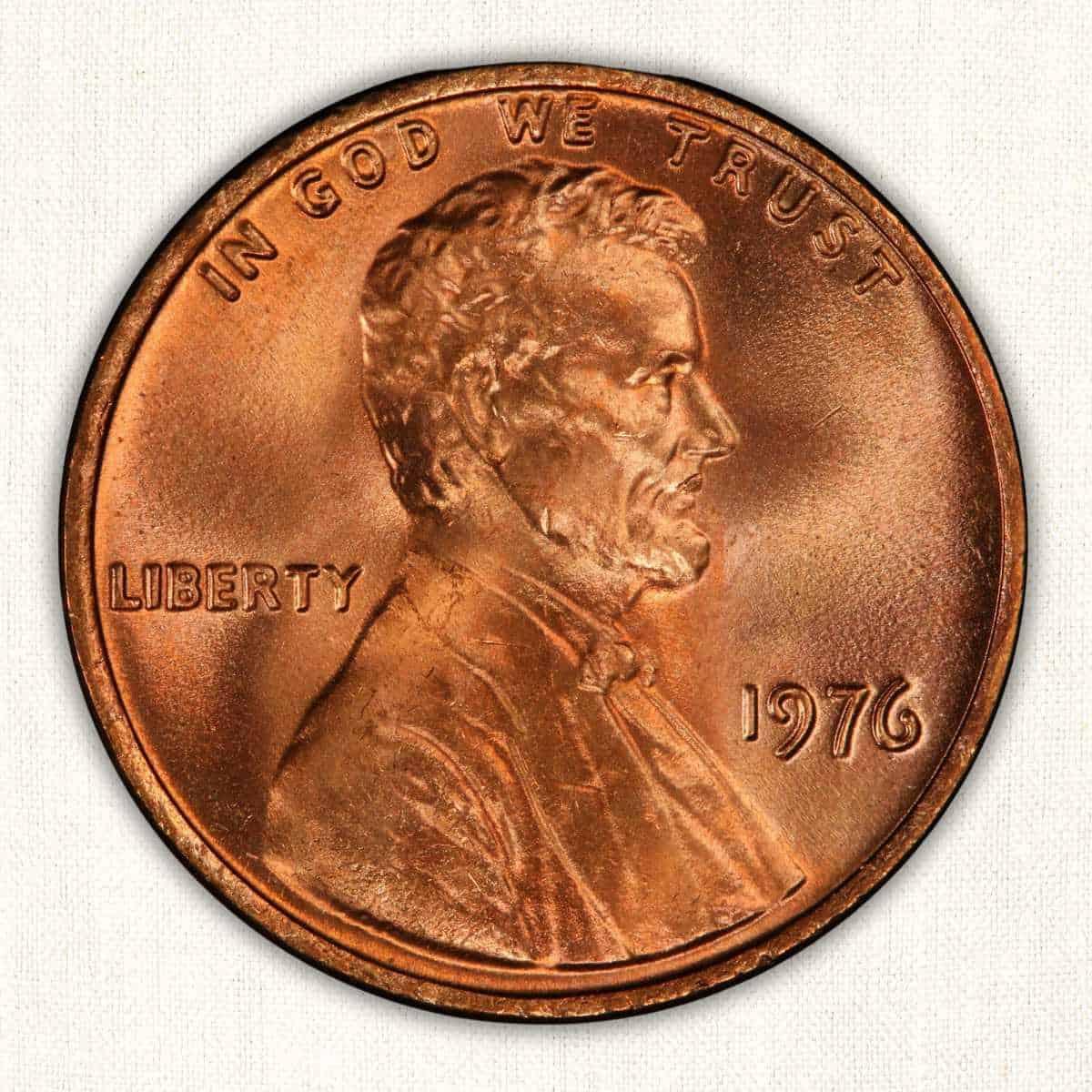
The Philadelphia Mint produced 4,674,292,426 pieces of 1976 Lincoln Penny. However, according to the United States Mint, not all the no-mint mark coins were from Philadelphia.
The West Point Bullion Depository also released circulating pennies from 1973 to 1986. However, both Mints did not include a mintmark on their coin, resulting in indistinguishable origins.
Based on the PCGS survival estimate, the 1976-P Lincoln Cent has roughly 934 million known examples today. With those massive numbers, it is considered extremely common. MS 66 is difficult to find, but if one searches through rolls and mint sets, they can get one.
MS 67 is similarly hard to find, but hundreds are graded and sold for a premium price. However, MS68 is very difficult to obtain as these coins are the prime of this variety. If you have a pristine 1976 cent in the hiding, get it professionally graded, as acquiring an MS68 demands a strong premium.
| 1976-P Lincoln Penny Price Chart | |||
| Grade | MS BN | MS RB | MS RD |
| Circulated | $0.05 | / | / |
| About Uncirculated (AU50) | $0.05-$0.10 | / | / |
| Brilliant Uncirculated (MS60) | $0.10-$0.60 | / | / |
| Choice Uncirculated (MS63) | $0.75-$1.50 | $5 | $7.50 |
| Gem Uncirculated (MS65) | $2.50-$7.50 | $7.50-$15 | $12.50-$60 |
A circulated 1976-P Lincoln Penny is worth $0.05 and can fetch a higher price as its grade increase.
As expected, 1976-P BN pennies have a lower value for gem uncirculated for only $2.50 to $7.50. On the other hand, a 1976 RB Pennies can reach $15 if in mint condition.
An MS RD is currently valued at $12.50 to $60. But it can reach thousands in the open market, like some of its auction histories. For example, a 1976 1C MS68 RD was sold for a staggering $7,931.25 by Heritage Auctions.
1976-D Lincoln Penny Value

Denver minted 4,221,592,455 pieces of 1976-D Lincoln Penny—slightly lower than the Philadelphia Mint. All these coins are regular strikes, but the Denver production is subpar.
There are no exact details on what types of dies they used to mint the 1976 dated cents. But, the poor quality is evident in many examples. Additionally, MS67 is the highest grade available for this variety. But PCGS mentioned that if there is anything above it, it is automatically considered very scarce or rare.
Circulated grades up to MS64 condition 1976-D cents are easy to pull out from circulation. There are roughly 844 million graded examples, making it a common variety.
MS65 and MS66, however, are harder to find. But there are enough examples that are available at low prices. In MS67, as expected, it is very hard to find and requires a significant premium to purchase one.
| 1976-D Lincoln Penny Price Chart | |||
| Grade | MS BN | MS RB | MS RD |
| Circulated | $0.05 | / | / |
| About Uncirculated (AU50) | $0.05-$0.10 | / | / |
| Brilliant Uncirculated (MS60) | $0.10-$0.60 | / | / |
| Choice Uncirculated (MS63) | $0.75-$1.50 | $5 | $10 |
| Gem Uncirculated (MS65) | $2.50-$7.50 | $7.50-$15 | $15-$825 |
The 1976-D BN and RB value does not differ from the Philadelphia Mint coins. It still starts at $0.05 and reaches $15 for uncirculated coins. However, a 1967-D MSRD Lincoln Penny offers a higher value, ranging from $10 to 825. It is because Denver-minted coins are a million lower in known examples than those from Philadelphia.
With auction history, the 1976-D Lincoln Penny has a few insightful records. The highest known account for this variety is an MS60 sold at $1,265 by Stack’s in 2007. For an MS67RD, the highest sale price is $998.75, sold by Heritage Auctions in 2016. The rest on the list range around $6 to $978, with grades from MS64 to MS67.
1976-S Proof Lincoln Penny Value
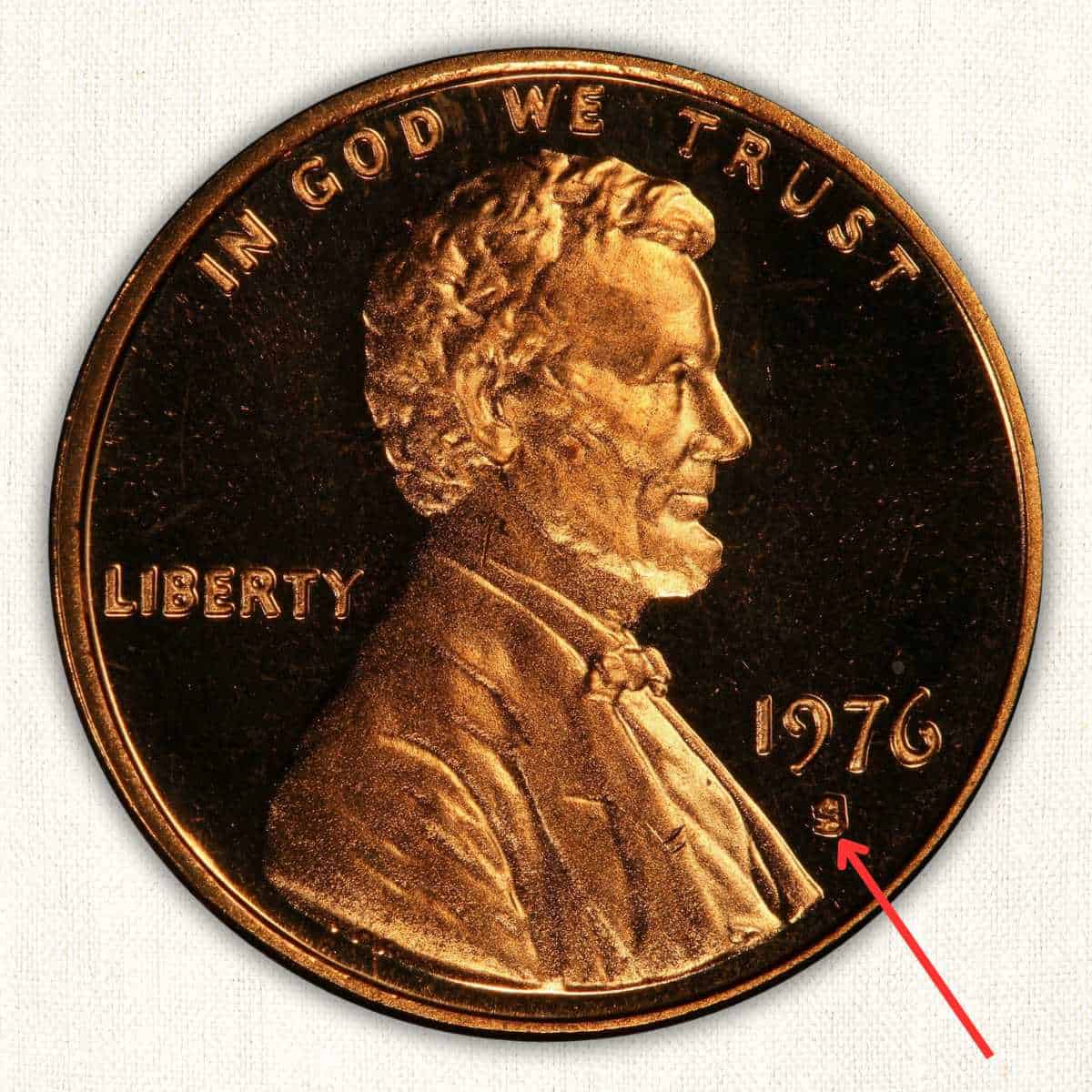
The San Francisco Mint produced 4,149,730 pieces of 1976-S Proof Lincoln Penny. Considering other years, the 1976-dated coins have a hefty amount that made it common. According to PCGS, the 1976-S Lincoln Penny—all conditions—have over 3 million examples. Most of them have PF60 to PF64 grades. On the other hand, those with PF65 and above designation have well over 2 million specimens. Still, it is a common coin for the series.
All proof coins have a red luster, thus the code RD. It is further classified based on strike characters—Cameo and Ultra Cameo.
Proof Red Cameo (PF RDC) has frosted devices and inscriptions contrasting the coin fields. Proof Red Ultra Cameo (PF RDU), similarly, has excellent contrast yet deeper in effect—earning its other title of black and white cameo. Now—let’s see how much these are worth today.
| 1976-S Proof Lincoln Penny Price Chart | ||
| Grade | PF RDC | PF RDU |
| PR-60 | $1.50 | $0.25-$0.35 |
| PR-63 | $2.10 | $1-$1.25 |
| PR-65 | $4.50 | $2-$2.50 |
| PR-67 | $13 | $7.50-$10 |
| PR-69 | $35 | $130 |
As of writing, the numismatic value of this variety is $0.21-$1.50 in average condition and can fetch $35 to $130 for the highest grade. But, in the open market, the value can soar up to thousands of dollars. An example is the auction record with a sale price of $1,208 for a 1976-S Cent PR69 Deep Cameo.
1976-S Proof Historical Prices: An Overview
The regular strike 1976 Lincoln pennies have consistent numismatic value for the past years. But the proof coins showed insightful records since they made rounds in the market.
A 1976-S PF69 Cameo has a numismatic value of $20.00 from 2006 until the second quarter of 2014. It only rose in 2015, maintaining a worth of $35 in the following years.
Meanwhile, the 1976-S PF69 Ultra Cameo Lincoln Penny shows continuous changes from the previous years. Its numismatic value started at $250 in 2006. In the same year, it reached its highest of $275 before dropping to $175 in 2008. In 2014, it maintained a value of $150 for a few months before stumbling to $130 in 2015, which remained unchanged until today.
List of 1976 Error Coins and Their Estimated Market Value
With over 8 billion minted, it is inevitable not to produce error coins. PCGS has recorded several 1976 Lincoln Cent Errors, including the famous 1976-D Lincoln Cent on the 10-cent planchet. It sold at a whopping $978. But let’s see the other error examples, including their estimated market value.
1. 1976-D Double Struck 2nd Strike 95% Off-Center Lincoln Cent
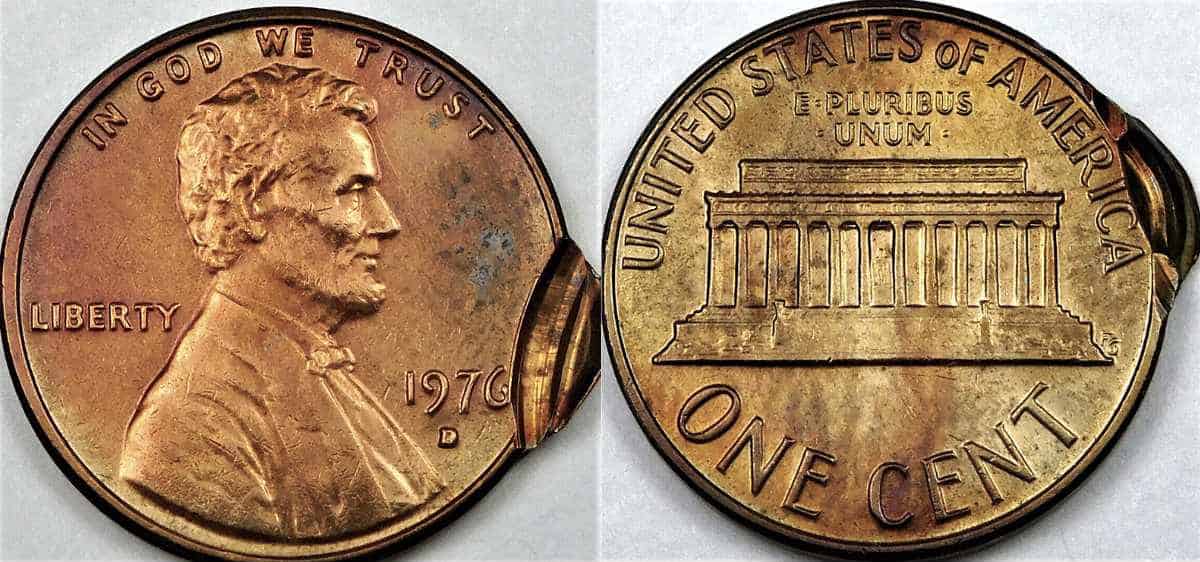
Double-strike mint error is popular among coin collectors. This error occurs when the coin gets struck twice, which results in an on-center or off-center design. But its dramatic effect and unique characteristics make it more valuable.
In the photo, you’ll see the first strike is already leaning towards more on the right. The second strike, however, is 95% off-center, leaving an extended metal piece on the coin. This type of error can sell for $70 to $400 but can value more if in good condition.
2. 1976 Double Die Error Lincoln Cent

There are a handful of double-die errors in the Memorial Reverse Lincoln Cent series, including the 1976-dates ones. Here, you’ll notice that the inscriptions “E PLURIBUS UNUM” and the “UNITED STATES OF AMERICA” have evident doubling. Other examples also show doubling on Lincoln’s profile.
This error can range from $1 to $6 for circulated coins, but those in mint state can fetch up to a hundred or thousands of US dollars.
3. 1976 Clipped Planchet Error Lincoln Cent
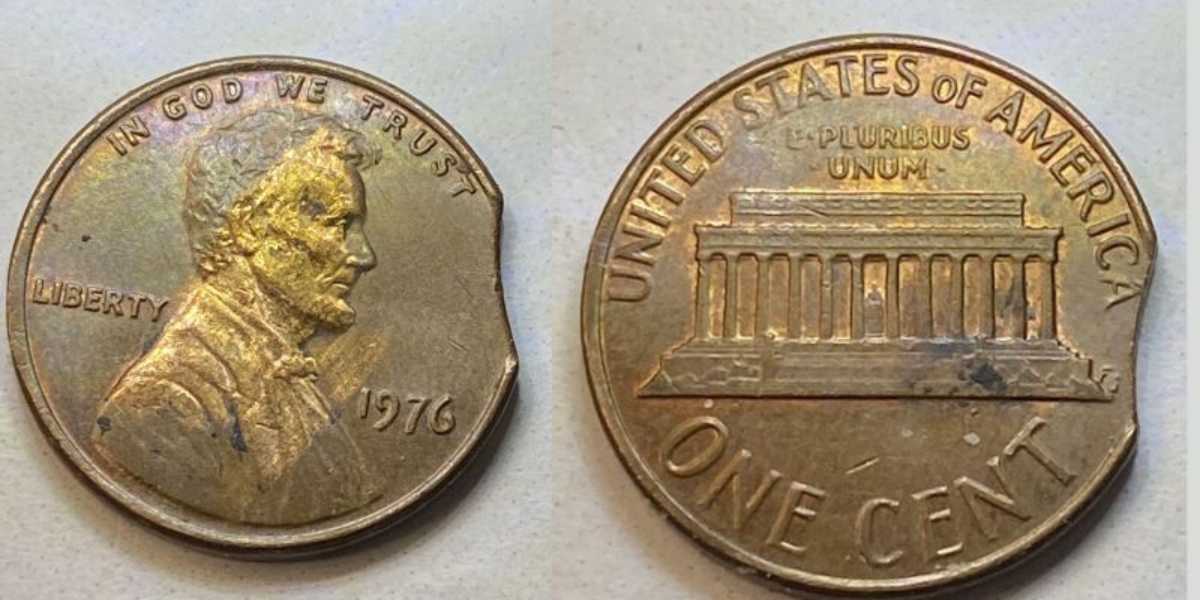
A clipped planchet is the most straightforward error to spot since the coin is missing a piece. It’s just a matter of how well you’ll determine if it is a genuine clipped planchet.
To check if it is legitimate, look for the opposite side of the clipped metal and inspect if there are any rim weaknesses. If it showed a flatter rim (like in the photo), you can assure it is the real deal.
Lincoln Cents in 95% copper with clipped planchet error can fetch $1 to $60.
4. 1976 Off-Center Strike Lincoln Cent

Aside from double-struck coins, the off-center strike is another popular mint error among collectors. As the name suggests, this happens when the coin’s design is struck off-center the planchet.
Additionally, it can only be classified as an off-center if an element is missing. For circulated Lincoln cent, it can range around $6 to $30, while uncirculated can fetch as high as $200.
5. 1976 Improper Alloy Mix Mint Error Lincoln Cent

This type of error may happen in two scenarios. First is if the Mint mixed the wrong proportion of the two metals. The second is if the coin manufacturer used the ideal quantity but did not mix the compound well. Although, these two situations can happen at the same time.
The result can be too much of a brassy color and overweight or has light and dark bands on the fields like in the photo. This error tends to be around $10 and can go higher depending on the condition.
Find More Penny Values
Year | Value (G4-MS60) | Rare Record |
$0.50-$70 | $14,950 | |
$3-$25 | $45,600 | |
$1.5-$40 | $40,250 | |
$0.50-$30 | $38,813 | |
$2.50-$90 | $14,375 | |
$2.50-$100 | $36,800 | |
$1-$14 | $9,000 | |
$1-$42 | $12,600 | |
$1-$100 | $45,600 | |
$0.12-$6 | $55,813 | |
$0.17-$9 | $4,080 | |
$0.17-$14 | $23,000 | |
$0.05-$0.50 | $10,350 | |
$0.05-$0.50 | $3,000 | |
$0.05-$0.50 | $1,997 | |
$0.05-$0.50 | $10,575 | |
$0.05-$0.50 | $15,275 | |
$0.05-$0.50 | $10,800 | |
$0.01-$30 | $14,140 | |
$0.01-$24 | $7,475 | |
$0.01-$24 | $3,410 | |
$0.05-$2.50 | $31,200 | |
$0.05-$2.50 | $7,638 | |
$0.05-$2.50 | $1,880 | |
$0.05-$0.10 | $5,887 | |
$0.05-$0.10 | $6,999 | |
$0.05-$0.10 | $6,463 | |
$0.05-$0.10 | $4,945 | |
$0.05-$0.10 | $5,750 | |
$0.05-$0.10 | $7,475 | |
$0.05-$0.10 | $4,406 | |
$0.05-$0.10 | $3,290 | |
$0.05-$0.10 | $4,250 | |
$0.05-$0.10 | $1,955 | |
$0.05-$0.10 | $9,000 | |
$0.05-$0.10 | $4,113 | |
$0.25 | $1,150 | |
$0.05-$0.60 | $7,931 | |
$0.05-$0.60 | $1,265 | |
$0.25-$1.50 | $1,208 | |
$0.01-$0.03 | $4,113 | |
$0.01-$0.03 | $1,024 | |
$0.01-$3.00 | $1,380 | |
$0.05-$0.60 | $1,553 | |
$0.05-$0.60 | $1,150 | |
$0.25-$0.35 | $863 |
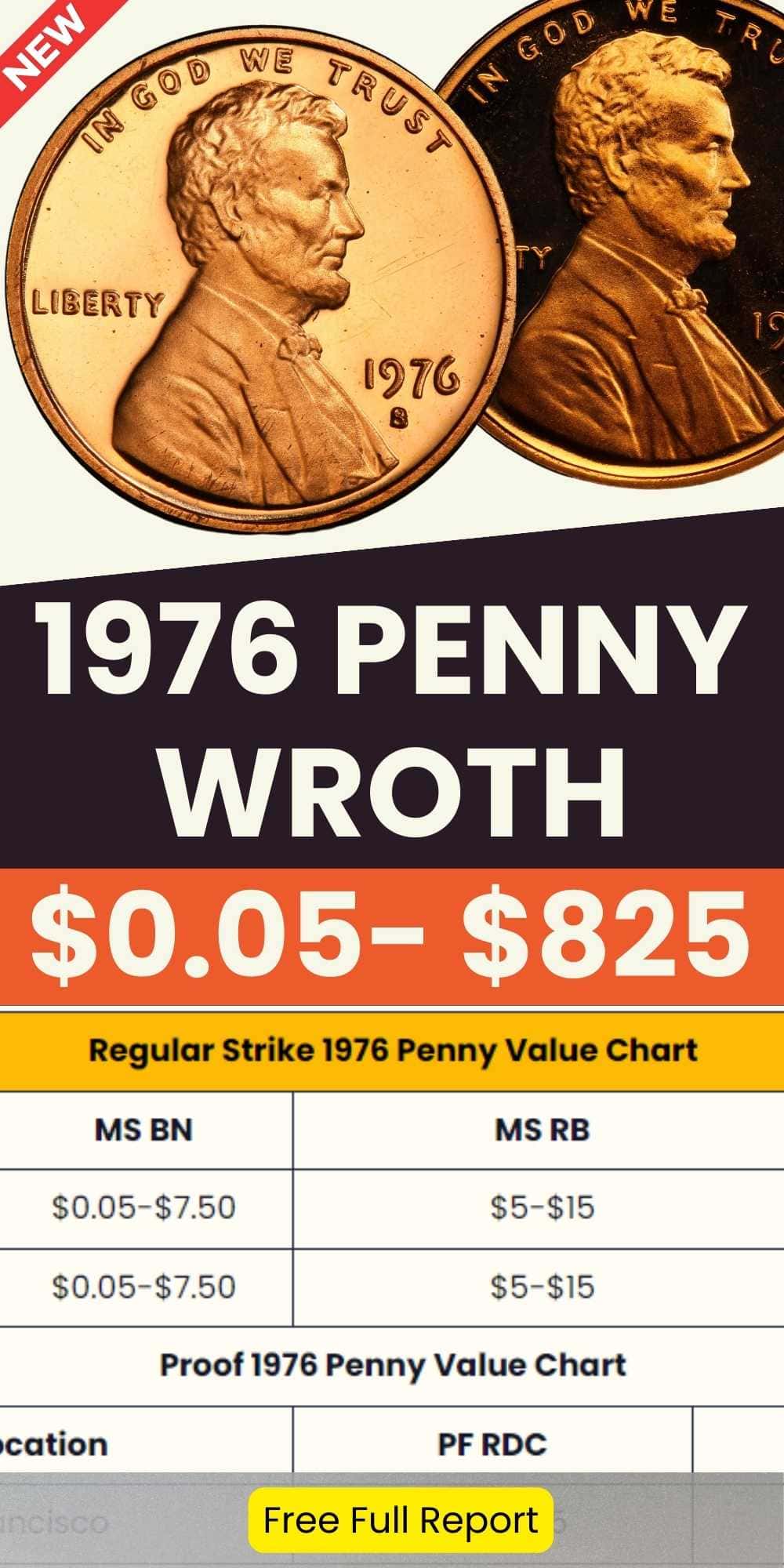

Jenson is a professional numismatist, a dedicated coin collector, a graduate of the College of Business at Oregon State, a life member of the American Numismatic Association (ANA), and an overall coin nerd. He is the founder of Coin Value List.
